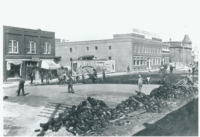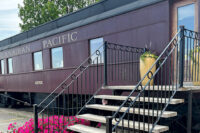‘Enchodus’ fossil found at ammolite site
By Woodard, Dale on July 27, 2020.
Dale Woodard
Lethbridge Herald
It was a fossil find with a bit of bite.
A Lethbridge-area ammolite mine was the site of a pair of fossil findings last month.
When they were finally able to get on the scene, a crew from the Royal Tyrrell Museum of Palaeontology uncovered some sea life from the Bearpaw Formation from approximately 74 million years ago.
“That is marine rock, so at that time Alberta would have been part of an inland seaway,” said Dr. Lorna O’Brien PhD, head technician of the Royal Tyrrell Museum of Palaeontology. “That’s why we have those marine animals. We get marine reptiles and fish and that’s how we have the ammonites they’re mining for. They’re mining for the ammolites, but those ammonites are sea-dwelling creatures.”
The crew at the ammolite mine made the discoveries June 25 and 26 and put the word out to the Royal Tyrrell Museum of Palaeontology, who responded June 29.
The dig, however was delayed.
“That was when the weather was really bad there,” said O’Brien. “They ended up having more water in the mine than they had ever had before. So we weren’t able to collect anything that week just because it was so wet. So we ended going back the following week.”
The location also presented a challenge in the excavation.
“Sometimes it’s not exactly clear what we’re going to get because it’s often quite challenging, because with the fossils in that area, the vertebrate fossils tend to be quite dark in colour and the rocks are dark in colour,” said O’Brien. “So often, we know they’ve hit bone, but we’re not entirely sure what.
“We know the bone they hit had teeth in it and they were reasonably sized, but it wasn’t until we returned to the quarry on July 6 that we were able to determine what it was.”
The find was a type of fish called “enchodus,” said O’Brien.
“In that area they can be a pretty large fish. They’re really nasty-looking. They have big, pointy teeth in their jaws. That skeleton was was no longer in its anatomical position. The bones had pulled apart from each other, so they were spread out over a couple of square metres.
“While we were there we also picked up other material they had found, including other fish remains, a really beautiful cuttlefish, which is a type of squid. They are known from that area, but this was one that was really nicely preserved.”
The find at the ammolite mine was, by the museum’s standards, a small jacket, said O’Brien.
“So we were able to collect that in a couple of days. We stay there until we have all the fossil material collected and then we bring it back to the museum. When it’s at the museum, it depends on how high of a priority it is for our research scientists as to how quickly that would go into the preparation lab.
“That would be my area as well. I’m responsible for the technicians who go out and respond to it and they are the same people who prepare the fossil material. That’s the process of removing the rock from the bone.”
Royal Tyrrell Museum of Palaeontology crews usually consist of four or five people, allowing them to spread out and start the excavation process, said O’Brien.
“Some of it moves really quickly and some of it moves really slowly. The first thing we do when we get on site is assess over what area the fossil is distributed and then try and set up the limits for that. At that point, once we think we have exposed the fossil material then we can start trenching down and digging around it to create a support jacket.”
An industrial site having large equipment helps the crew immensely, allowing them to work faster than they might be able to on a regular dig.
“We can collect something that would be an equivalent size there (that) might take us weeks or months somewhere else because we don’t have that industry equipment right there. Definitely, industry calls are different to our regular, run-of-the-mill work, but some of our technicians really enjoy that because of the speed at which it could happen. A lot of it is reactionary, because we don’t know what people are going to find. So when they send a report to us we try to mobilize a crew as quickly as possible.”
Last month’s find wasn’t the first location of fossils in the area.
“In a situation like this when it’s a mine site and they’re excavating for fossils in the first place, we know there’s a high chance of them hitting vertebrate material,” said O’Brien. “We’ve collected quite a few marine reptile and dinosaur skeletons from this area. As part of our historical resources responsibilities, when industry calls us and says ‘We’ve found something,’ we have to send a crew out and respond to that and we do an excavation from there.
“They’re allowed to collect the things their permit is for, so in this case ammolites and ammonites. But when they hit other things, especially vertebrate material, they call us in and we take care of it. It’s a really nice way for us to be able to collect that kind of material we wouldn’t ordinarily get to see because we wouldn’t be doing excavations in that area as a museum. So in that sense we can piggy back onto the industry operation there and get some really nice specimens when they turn up.”
Follow @DWoodardHerald on Twitter
28-27




